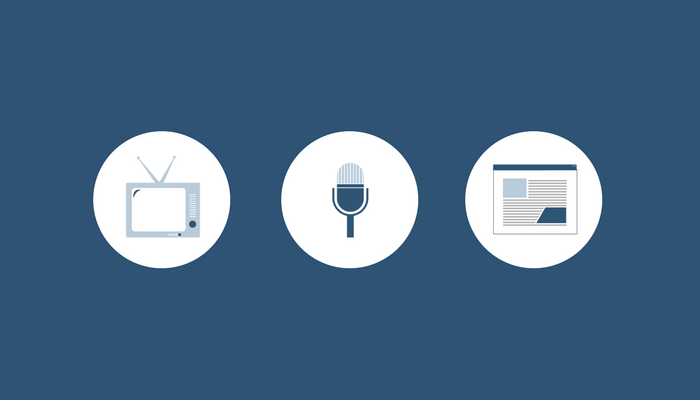Fostering Media Relationships for a Strong PR Program

Posted By Matt McCarthy on March 14, 2018
Let’s face it, pitching the media can be hard work.
Journalists are busy and stretched thin and as a result can be short and rushed. And in today’s world where people can work from anywhere, it can be difficult to reach them by phone or email. Direct phone number are rarely listed, and oftentimes only general email addresses are provided or worse yet, a there is only a contact form on their site that goes directly to their junk email folder. At times it can feel like the media are doing their best to be virtually unreachable.
Despite all of these challenges, not being able to connect with a reporter is simply not an option. So what can be done? Here are a few pointers to help build relationships with key journalists and keep those relationships strong for months and years to come.
Time Is Valuable
When journalists are gruff on the phone with you, it is typically because they are on deadline. Be mindful of this and ask them if it is a good time for them to talk. If they can spare a few minutes to listen to you make sure you have your elevator pitch ready. This pitch needs to be customized for the journalist and publication you’re pitching. Rattle off a generic pitch and prepare to be tuned out.
Be brief but concise and let them know why your news is important to their readers. With any luck, they may want to set up a time to talk to your client. If they say they will need more time to review your email pitch before making a decision, schedule time to follow back up with them.
By being respectful of their time and understanding that you are willing to follow up with them when they are most comfortable, they may be more inclined to review what you sent and either reconnect with you to set up an interview or provide you with feedback to better target them the next time you send them a pitch.
Show Genuine Interest in the Journalist’s Work
Prior to pitching any journalist, you should do thorough research into the topics that they cover and have written about. After you have worked with them, you should continue to do the same thing.
Journalists appreciate when you let them know you have read what they have written. Sending a one-off note to them to let them know their latest piece really hit the mark is a simple way to keep you on their radar. Likewise, following them on social networks and responding to their posts is a good way to stay top of mind with them.
Get Your Client Established as an Industry Expert
While there are many top-level news outlets that do not accept contributed content, there are many trade outlets that are happy to. More than ever trade outlets, which can be extremely important to clients as they help influence in purchasing decisions, are hungry for contributed content from industry experts who understand their coverage areas and can deliver opinion pieces on the news and trends impacting their markets.
By pitching and establishing your client as a regular contributor who can deliver this content, you can build a relationship with editors and be seen as a much-needed resource. As you continue to build the relationship, your client can become a trusted source that can provide insights into the larger feature stories the editors are developing.
This is a win-win scenario for both your client and the trade outlet. The client gains the exposure they are looking for and the prestige of being seen as a significant personality in their field. The editor is happy because he has a steady stream of top-notch content coming their way that is free and can help their news site become more valuable to its readers and advertisers.
Never Miss an Opportunity for Facetime
As mentioned above, it’s difficult to break through to a journalist through email and by phone. There are thousands of other PR professionals who are trying to do the same thing you are and a journalist has only so much time in their day to field calls and respond to emails.
That is why you should always take advantage of any events that will provide face-to-face time with journalists. It sounds silly but it is true: when you are able to connect a face with a name, it leads to more familiarity with that person. From there, you can build a rapport that will hopefully lead to a more fruitful working relationship. Trade shows are also a good place to meet journalists.
When you go to the event make time to connect with them one-on-one after their presentations. Let them know who you are, who you work with, and position yourself and your clients as go-to resources they can tap for news stories. The journalists may not have much time to speak with you, so make sure you exchange business cards, which also may gain access to those valuable phone numbers and email addresses.
Remember a Farmer Reaps What He Sows
Personal connections with journalists are precious. Like a farmer who benefits from the bounty of his harvest, PR practitioners also need to maximize the relationships they have already established with the journalists. they’ve worked with.
When a journalist responds to a pitch and expresses interest in speaking to your client or accepting a byline from them, make sure you give that journalist the same “white glove” service you would to your client. Provide them additional information on the client/subject matter that will help them better prepare for the interview. Ask if photos might be needed and help coordinate photo shoots as necessary.
Be sure to follow up with the journalist after the interview to make sure all their questions were answered. If they send an email with a request, make sure you respond promptly.
If you are delivering a byline to them, make sure you establish a set deadline of when they will receive it and make sure you follow up promptly with any questions or edits they have to make sure the process moves forward swiftly.
By doing this, you will show the journalist that you are a resource that is helping them do their job and they will remember that the next time you send a pitch their way.
Take Your Time and Be Smart
Building relationships with journalists takes time so don’t be discouraged if you are unable to establish that connection right away. Think of it like how you have built relationships in your own personal life. Those were built from shared interests that eventually lead to familiarity.
Showing a journalist that you are respectful of their time, understand their beat and are familiar with their work, it should be enough to get your foot in the door. From there, impress upon them that you and your client can be a valuable resource to them that will help make their jobs easier.
Once you and your client are able to deliver on that promise by either delivering a byline or lending commentary to a story, that journalist will see the value you bring and will be more likely to work with you again and again.



